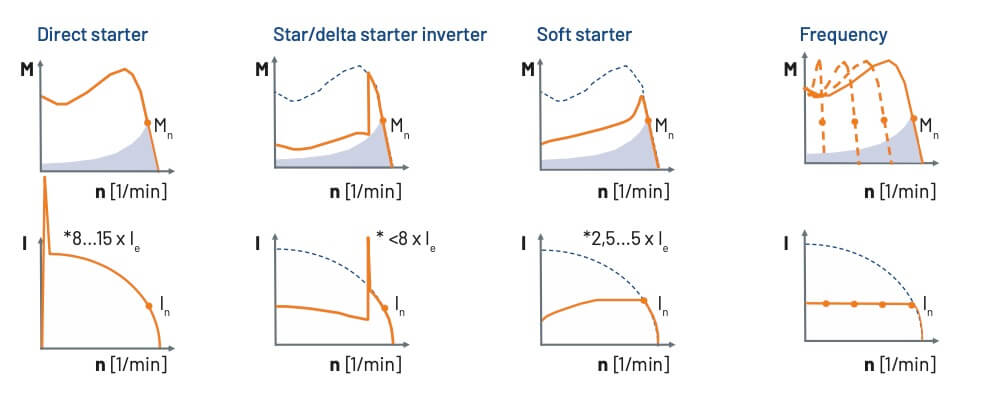Motor and machine
Since its invention well over 100 years ago, the three-phase motor has become increasingly popular as a drive unit. Today, it is the most widely used electric drive.
Electric motors in industrial and commercial use consume a significant proportion of global energy production. If the efficiency of all these electric drives increases, their environmental compatibility improves due to C02 savings and electricity consumption decreases. In non- speed-controlled applications, the soft starter is an effective element in this drive axis to reduce the power requirement and start the motor gently. In these cases, soft starters are always the more energy-efficient solution than frequency inverters.
Limit high inrush current
The high efficiency of high-efficiency motors (efficiency level IE3 or higher) reduces energy consumption. However, their use has two main disadvantageous effects when the electric motors are switched on directly: firstly, the starting currents of these high-efficiency motors are many times higher than those of previous standard motors and secondly, the torques are up to three times higher.
While conventional motors generate an inrush current that is 6 to 8 times higher than the rated current of the motor when they are switched on, energy-efficient motors require
a starting current of up to 15 times the rated motor current when they are started. The increased torque results in a sudden mechanical load in the machine, which shortens the service life.
These undesirable effects can lead to faults in the mains supply or triggering of overcurrent protection devices or, for example, to pressure surges in pump systems.
Starting engines – it’s all about the right method!
With the increasing market penetration of three-phase motors, the desire for suitable starting behavior grew in order to eliminate the unpleasant side effects mentioned above. Solution concepts through electrical measures in the mains supply and Mechanical meas- ures, such as slipping clutches, have been developed over time. An overview of the various electrical starting methods is shown in the following list. A look at the current or torque characteristics shows the behavior of each starter solution.
Features
Direct start-up
- Three-phase motor of low and medium power
- 3 wires to the motor
- High starting torque
- High current peak
- Voltage dip
- A simple switching device
Star-delta start-up
- Three-phase motor with low to high power
- 6 wires to the motor
- Reduced starting torque, 1/3 of the nominal torque when starting in Y
- High mains load due to current peak when switching from Y to Δ
- High mechanical stress due to torque jump when switching from Y to Δ
- Many high-maintenance switching devices with large space requirements in the control cabinet
Soft start-up
- Three-phase motor with low to high power
- 3 wires to the motor
- Variable starting torque
- No current peak
- No torque shocks
- Insignificant voltage dip
- A simple switching device
- Optional: Guided soft stop, protective functions, etc.
- Maintenance-free
Comparison of the various starter methods

* applies to energy-efficient motors
All values and illustrations shown here are simplified and idealized
Compared to contactor solutions, soft starters offer considerable advantages.
In the characteristic curves shown, clear torque jumps as well as high currents and current peaks of the contactor solutions can be recognized:
- Torque shocks mean high mechanical loads on the machine, resulting in higher service costs and increased wear.
- High currents or current peaks lead to high supply costs from the energy supply companies (peak current calculation) and high mains or generator loads. A soft starter controls the voltage supply of the three-phase motor continuously during the start-up phase. This adapts the motor to the load behavior of the driven machine. Mechanical equipment is accelerated particularly gently. Service life, operating behavior and work processes are positively influenced.
Negative influences are avoided, such as:
- Impact of tooth flanks in the gearbox
- Reduction of pressure surges in pipework systems
- Slipping of V-belts
- Jerk effect with transportation equipment
EMC made easy:
- No shielded motor cables required
- No radio interference suppression filters necessary
- No sine or du/dt filters necessary
As the soft starters mainly have a controlling effect on the three-phase motor during the start-up phase (optionally also during the run-down phase), it is not possible to permanently influence the motor speed. This is because after the three-phase motor has started up in most soft starters, the controlling power semiconductors are bypassed by an internal bypass (contactor or relay). In soft starters without an internal bypass, this is usually done externally in order to avoid the high energy losses of the controlling power semiconductors. Permanent speed control is therefore not part of the function of a soft starter.
The IEC/EN 60 947-4-2 product standard applies to soft starters. Compliance with the stand- ard and thus the assurance of the high-quality standard is documented by the manufactur- er’s declaration of conformity.
Design variants of soft starters
A general distinction is made between the following design variants:
Soft starters for standard tasks
- The main areas of application are small to medium outputs
- As a replacement for star-delta combinations
– Reduced wiring effort
– Less space required
– Fewer possible sources of error
– Maintenance-free - For smooth operation during the start-up phase
- Optional soft stop offers advantages over the mechanical solution
Soft starters for challenging tasks
- The power range goes up to 1200 kW (compact devices)
- Voltage levels 200 / 400 / 500 / 690 V
- All devices have an adjustable current limiting function to prevent current peaks
Further important device characteristics:
- Motor protection functions (optional)
- Monitoring and protection functions for mains and soft starter
- Parameterization functions for optimizing the application
- Control commands (various inputs)
- Signaling contacts, e.g. for:
– Control of an external bridging contactor
(reduced power loss during continuous operation)
– Monitoring signals
– Fault messages (e.g. mains, soft starter, motor) - Communication (optional), e.g. via field bus systems
- Inside-delta circuit (for the use of smaller soft starters)
- Torque control (optional) for particularly difficult start-up tasks
Soft starter with internal bypass contacts
- Savings in power loss during continuous operation (after start-up)
- Compact sizes save space in the control cabinet

Two-phase and three-phase controlled soft starters
Soft starters differ, among other things, in the number of controlled phases; there are two- phase and three-phase controlled variants. Two-phase controlled products have up to 50 % less current in the controlled phases than in the uncontrolled phase (current unbalance). This leads to a slight increase in the temperature of the motor winding during the starting phase. However, the effect of the current unbalance is negligible. In terms of performance, safety and reliability, there is no significant difference between two-phase and three-phase controlled soft starters. In most cases, two-phase controlled products offer the advantage of compact dimensions, as components are saved. In addition, they can be built more cost-efficiently. For tasks requiring high performance paired with high functionality, such as precise phase current monitoring or the possibility of a inside-the-delta circuit, a three-phase controlled soft starter is recommended.
The soft starter and its areas of application
Soft starters can be customized to the requirements of the respective applications. The following overview provides a summary of driven machines, their operating mode (standard or heavy-duty starting) and the advantages of using soft starters.
For further orientation, the maximum starting current required in conjunction with the soft starters to ramp up to rated operation is listed.

Soft starter manufacturers
Leading manufacturers of soft starters have formed a working group within ZVEl, the German Electrical and Electronic Manufacturers’ Association.


ZVEI e.V.
Dr. Markus Winzenick
Division Automation
Product Division for Switchgear, Controlgear and Industrial Control Equipment
Lyoner Strasse 9
60528 Frankfurt am Main
Germany
Phone: +49 (0)69 6302-426
Mail: markus.winzenick@zwei.org
www.zvei.org


